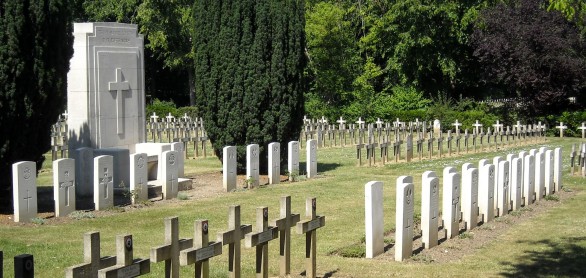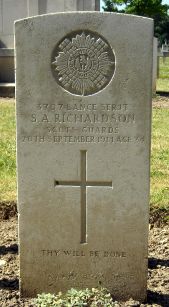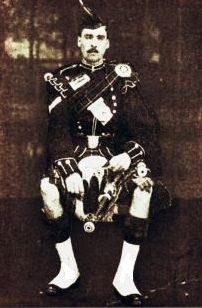

IN MEMORy by Pierre Vandervelden
The visit to Commonwealth graves in Communal Cemeteries & Churchyards in Belgium & France
City of PARIS Cemetery Bagneux (Hauts de Seine France)
 |
 |
 |
| Photos Courtesy Isabelle & Guillaume van der Wende |
 |
 |
| L/Sjt Samuel Alexander Richardson 20/09/1914
aged 34 Samuel Alexander was the youngest son of William Richardson, a railway porter (later to become an inspector) with the Great North Western Railway and Jane Richardson (nee Patterson). He was born at Woolmarket, Berwick-On-Tweed (near Spittal) on the 22nd June 1881, his siblings were Peter Alexander, Alexander Patterson, Thomasina Patterson and Jane. His father remarried after the death of his wife Jane in 1888 and from this marriage to a Margaret Wait became the step brother of Gladys Elizabeth. At the time of his birth, the family resided at 22 Woolmarket, Berwick-On-Tweed but by 1891 had moved to 24 Kiln Hill, Berwick-On-Tweed and at this point in Samuels’s life he was a pupil at a boarding school in Dumfries. No records suggest that he attended a military school. He attained a 3rd class certificate of education on the 28th September 1900 and a 2nd class certificate on the 27th August 1904. Upon leaving school Samuel was to join the ranks as a shoemaker, plying his trade in the area of Spittal, Northumberland. Becoming bored with this very mundane way of life and seeking adventure and travel, Samuel at the age of almost 19 years made the short journey to Newcastle-On-Tyne, and on the 30th May 1900 joined the colours of the Coldstream Guards as a private. A little over 7 months later on the 1st January 1901 Samuel was transferred to the 3rd Battalion Scots Guards and his service was extended to complete 7 years with the colours on the 12th November 1901. On the 2nd February 1905 his service was extended to complete 8 years with the colours and he was promoted to Lance Corporal on the 23rd November 1905. 9 days before his promotion to Lance Corporal and on the 14th November 1905, Samuel married Alice Gladys Frost, a spinster and brewers daughter from Stoke, Suffolk, at the register office in St. George, Hanover Square, London which suggests his posting prior to the event had taken him south from his family homestead in Berwick-On-Tweed. His address is noted on the marriage certificate as being 71 Westbourne Street, Pimlico which was also the address of his new wife Alice. A far cry from the poor streets of Berwick-On-Tweed, Pimlico would have been a very plush part of London at that time. He passed his primary test at the class of instruction on the 2nd January 1906. The 24th July 1906 saw the birth of their first son Alexander Patterson who was born at Wellington Barracks, London and on the 1st October 1906, Samuel was again transferred, this time to the 1st Battalion Scots Guards. His service was extended to complete 12 years with the colours on the 13th March 1908 and 2 months later on the 11th May 1908 his first daughter Jane Patterson was born at the Wellington Barracks in London. On the 30th March 1910 his second son Samuel Alexander was born at North Camp, Aldershot. On the 1st February 1911 he was promoted to Corporal and was engaged for the Scots Guards in Cairo, Egypt for such time as shall complete 21 years service on the 10th October 1911. His base was to be Kasr-el-Nil barracks where his regiment were assigned to complete/repair the building of the infamous Kasr-el-Nil bridge which spans the River Nile. He left for Egypt with his wife Alice and 3 children Alexander, Jane and Samuel on the 25th February 1911 and completed this tour of duty on the 1st January 1913. During that time and on the 28th February 1912 his second daughter Grace Patterson was born. From the 2nd January 1913 to the 12th August 1914, Samuel was on home soil residing at the Aldershot barracks in Hampshire with his family before his call to the Western Front saw him leave for France and Flanders on the 13th August 1914. The adventure and action that Samuel had sought back in 1900 was about to begin for real but was to be very short lived. This kind gentle man and devoted husband and father of 4 beautiful children was leaving his family behind to fight for king and country which would see him endure just 32 days of action before he was to be wounded in action then die from his wounds in a Paris military hospital. On Monday 14th September 1914, the Germans were making a determined resistance along the River Aisne. Opposition, which it was at first thought might possibly be of a rear guard nature, not entailing material delay to the Scots Guards progress, developed and proved to be more serious than was anticipated. The action, now being fought by the Germans along their line, may, it is true, have been undertaken in order to gain time for some strategic operation or move, and may not have been their main stand. But, if this was so, the fighting was naturally on a scale which as to extent of ground covered and duration of resistance, made it undistinguishable in its progress from what was known as a ‘pitched battle,’ though the enemy certainly showed signs of considerable disorganization during the earlier days of their retirement phase. Whether it was originally intended by them to defend the position they took up as strenuously as they had done, or whether the delay gained for them during the previous 2 days by their artillery, had enabled them to develop their resistance and force their line to an extent not originally contemplated cannot be said. The action still being contested was the Battle of Aisne. The foe being fought were just across the river along the whole of the front to the east and west. The struggle was not just confined to the valley of that river, but the Battle of Aisne would be deemed in history as a memorable battle. The progress of operations for the 14th September 1914, the very day Samuel sustained a gunshot wound to his right shoulder can be described. The troops which had on the previous day crossed the Aisne, after driving in the German rear guards on that evening, found portions of the enemy's forces in prepared defensive positions on the right bank and could do little more than secure a footing north of the river. This, however, they maintained in spite of two counter-attacks delivered at dusk and 10.00 pm, in which the fighting was severe. Strong re-enforcements of troops were passed to the north bank, the troops crossing by ferry, by pontoon bridges, and by the remains of permanent bridges. Close cooperation with the French forces was maintained and the general progress made was good, although the opposition was vigorous and the state of the roads, after the heavy rains, made movements slow. One division alone failed to secure the ground it expected to. The First Army Corps, after repulsing repeated attacks, captured 600 prisoners and twelve guns. The cavalry also took a number of prisoners. Many of the Germans taken belong to the reserve and Landwehr formations, which fact appears to indicate that the enemy was compelled to draw on other classes of soldiers to fill the gaps in his ranks. There was heavy rain throughout the night of 14th September. The situation of the British forces underwent no essential change. But it became more and more evident that the defensive preparations made by the enemy were more extensive than was at first apparent. In order to counterbalance these, measures were taken by the British to economise the troops and to secure protection from the hostile artillery fire, which was very fierce. Our men continued to improve their own entrenchments. The Germans bombarded our lines nearly all day, using heavy guns, brought, no doubt, from before Maubeuge, as well as those with the corps. All their counter-attacks, however, failed, although in some places they were repeated six times. One made on the fourth guard brigade was repulsed with heavy slaughter. The Scots Guards war diary for this date states ‘The battalion moved at 5.30am via Moulins and Vendresse to a hill between that place and Troyon, 2 companies in brigade reserve and 2 companies sent as artillery escort to Tour de Passy’. The casualties for this day is recorded as 3 officers and 16 men killed, 3 officers and 86 men wounded of which one of those was Samuel, and 12 missing. Samuel was transported some 230kms in horrendous conditions to the Majestic Hotel in Paris which was then serving as a military hospital for the sick and wounded and 6 days after his internment on the 20th September 1914 at 1.00pm in the afternoon, Samuel lost his fight for life and died agonisingly from the gunshot wound to his right shoulder sustained at the Battle of Aisne. The medical officer named Armstrong Smith completed Samuel’s death certificate in French whereupon it is noted that he died from severe chest complications. for his grandson John Richardson |
|
35 casualties
ADDISON A
United Kingdom Private Northamptonshire Regiment 1st Bn. Date of Death: 26/09/1914
Service No: 9598 19.I.B.2.
ASHBY THOMAS
United Kingdom Lance Corporal King's Royal Rifle Corps 2nd Bn. Age: 32 Date
of Death: 24/09/1914 Service No: 5636 19.I.B.1.
BLAKE R H
United Kingdom Private Wiltshire Regiment 1st Bn Date of Death: 26/09/1914 Service
No: 7719 19.I.B.7.
BRETTELL THOMAS alias JONES THOMAS
United Kingdom Private South Wales Borderers 1st Bn. Age: 28 Date of Death:
08/10/1914 Service No: 8693 19.I.A.2
BUCK W
United Kingdom Rifleman King's Royal Rifle Corps 1st Bn. Date of Death: 30/09/1914
Service No: 7071 19.I.B.6.
CALVERT HERBERT EDWIN
United Kingdom Private Coldstream Guards 3rd Bn. Age: 25 Date of Death: 24/09/1914
Service No: 6994 19.I.A.6.
CLARKE J
United Kingdom Private Coldstream Guards 3rd Bn. Age: 32 Date of Death: 18/10/1914
Service No: 5566 19.I.B.10.
DELL WALTER FREDERICK
United Kingdom Drummer Grenadier Guards 2nd Bn. Age: 20 Date of Death: 02/10/1914
Service No: 14373 19.II.A.7.
DORFBERGER MYER
United Kingdom Driver Royal Corps of Signals 51st Div. Sigs. Date of Death:
13/08/1944 Service No: 3534942 31.2.16.
FIFIELD ARTHUR HENRY
United Kingdom Serjeant Hampshire Regiment 2nd/4th Bn. Date of Death: 23/07/1918
Service No: 200962 19.II.A.1.
FRANKS F
United Kingdom Lance Corporal Durham Light Infantry 2nd Bn. Date of Death: 08/10/1914
Service No: 10548 19.I.A.1.
FULLER W
United Kingdom Private South Lancashire Regiment 2nd Bn. Age: 27 Date of Death:
27/09/1914 Service No: 7980 19.I.B.8.
GILLINGS ROBERT HENRY
United Kingdom Driver Royal Field Artillery 22nd Bty. Age: 29 Date of Death:
24/09/1914 Service No: 26152 19.I.A.3.
HALL J F D
South African Sergeant South African Infantry 4th Regt. Date of Death: 05/08/1918
Service No: 6891 19.I.B.11.
HANLEY J
United Kingdom Rifleman Royal Irish Rifles 2nd Bn. Age: 27 Date of Death: 21/09/1914
Service No: 7818 19.I.A.8.
HARTLEY W
United Kingdom Rifleman King's Royal Rifle Corps 2nd Bn. Date of Death: 07/10/1914
Service No: 5622 19.II.A.8.
HEATH ERNEST ALFRED
United Kingdom Private The Queen's (Royal West Surrey Regiment) 1st Bn. Age:
33 Date of Death: 26/09/1914 Service No: 9093 19.I.B.5.
JOHNSON FREDERICK
United Kingdom Private Border Regiment 2nd Bn. Date of Death: 01/08/1918 Service
No: 20035 Sp. Mem.
McCLAIR HARRY
United Kingdom Private Border Regiment 2nd Bn Date of Death: 01/08/1918 Service
No: 20037 Sp. Mem.
McMILLAN W
United Kingdom Corporal Royal Scots 2nd Bn. Date of Death: 28/09/1914 Service
No: 10315 19.I.B.4.
MEESE V J
United Kingdom Private Worcestershire Regiment 2nd Bn. Age: 25 Date of Death:
05/10/1914 Service No: 10065 19.II.A.3.
NYLAND J
United Kingdom Private King's Own (Royal Lancaster Regiment) 1st Bn. Age: 19
Date of Death: 04/10/1914 Service No: 10517 19.II.A.5.
OLIVER THOMAS GURNEY
Australian Lance Corporal Australian Infantry A.I.F. 3rd Bn. Age: 29 Date of
Death: 05/08/1918 Service No: 2943 19.II.A.4.
PETERS J
United Kingdom Private Queen's Own (Royal West Kent Regiment) 1st Bn. Date of
Death: 22/09/1914 Service No: L/7630 19.I.A.5.
PHELPS GEORGE THOMAS
United Kingdom Private The Queen's (Royal West Surrey Regiment) 1st Bn. Age:
28 Date of Death: 03/10/1914 Service No: 8669 19.II.A.11.
RICHARDSON S A
United Kingdom Lance Serjeant Scots Guards 1st Bn. Age: 34 Date of Death: 20/09/1914
Service No: 3707 19.I.A.7.
SMITH JOHN HUNTER
United Kingdom Private Black Watch (Royal Highlanders) 1st Bn. Age: 36 Date
of Death: 24/09/1914 Service No: 7465 19.I.B.9.
SNOOKS FRDERICK ERNEST
United Kingdom Corporal Queen's Own (Royal West Kent Regiment) 1st Bn. Age:
21 Date of Death: 02/10/1914 Service No: L/9707 19.II.A.9.
SOUTER ROBERT MILLER
United Kingdom Lance Corporal Highland Light Infantry 2nd Bn. Age: 29 Date of
Death: 23/09/1914 Service No: 8090 19.I.A.4.
TONGE JOHN
United Kingdom Driver Royal Field Artillery 46th Bty. Date of Death: 21/09/1914
Service No: 34366 19.II.A.2.
WALKER HARRY
United Kingdom Private Oxford and Bucks Light Infantry 2nd Bn. Age: 20 Date
of Death: 24/09/1914 Service No: 9787 19.I.B.3.
WILSON JOHN
United Kingdom Private Black Watch (Royal Highlanders) 1st Bn. Age: 25 Date
of Death: 20/09/1914 Service No: 916 19.I.A.9.
WILSON J R
United Kingdom Lance Corporal Scots Guards 1st Bn. Age: 22 Date of Death: 20/09/1914
Service No: 7726 19.I.A.11.
WOODWARD W
United Kingdom Drummer Queen's Own (Royal West Kent Regiment) 1st Bn. Date of
Death: 21/09/1914 Service No: L/9416 19.I.A.10.
WYCHE JAMES
United Kingdom Private Manchester Regiment 2nd Bn. Age: 28 Date of Death: 03/10/1914
Service No: 9333 19.II.A.10.
IF You have a casualty picture, please send me a copy, I'll be glad to show it on this page.
IF You want a king size copy of this picture (300/900 ko - 2592/1944 pixels) please e-mail me.
IF You want picture of a particular grave, in this cemetery, please e-mail me.
Casualties informations come usualy from Commonwealth War Graves Commission, see links for more informations
Inmemories.com © Pierre Vandervelden - Belgium